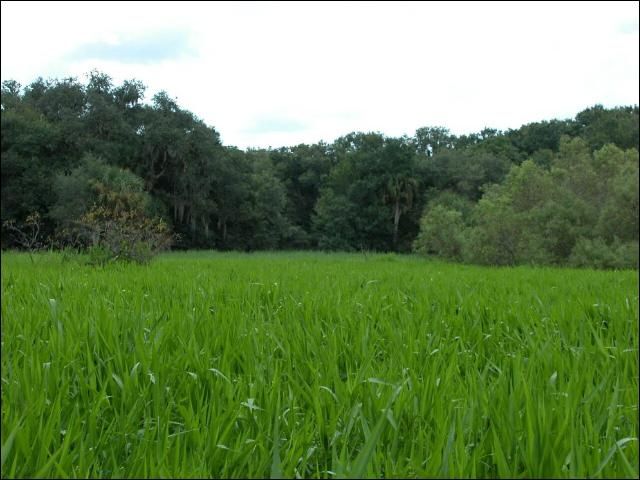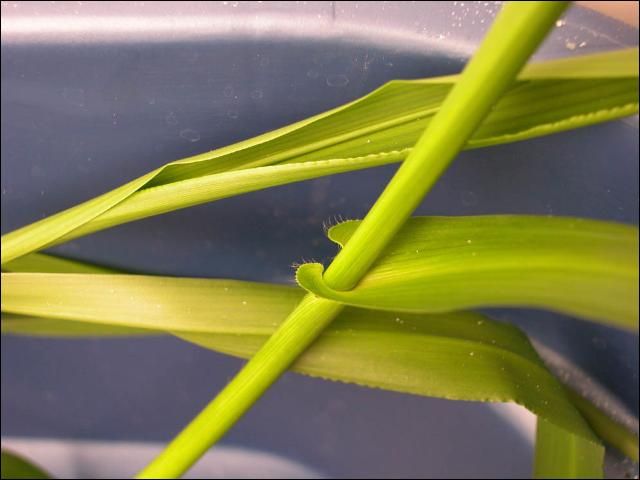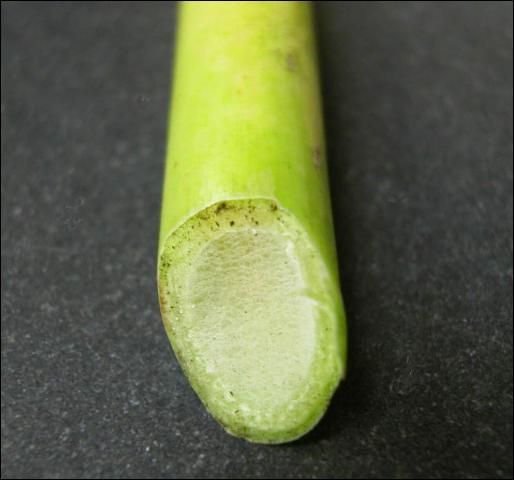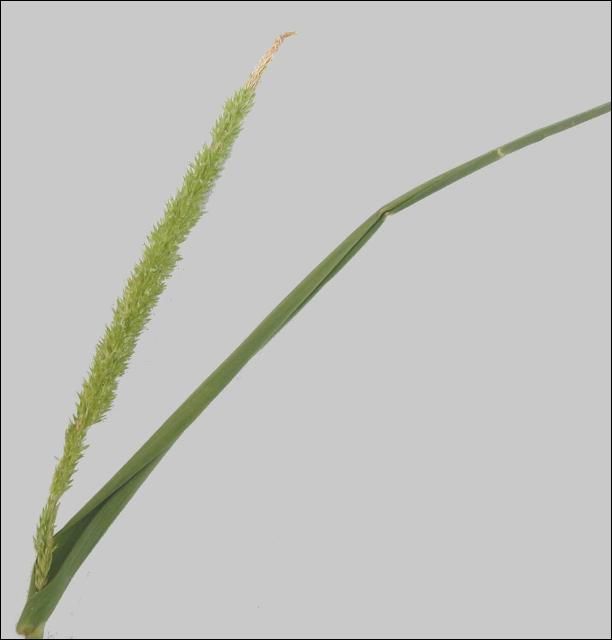Wetland Weeds: West Indian Marsh Grass (Hymenachne amplexicaulis)
Wetlands (including swamps, bogs, marshes, mires and lagoons) are important ecosystems that are found on every continent except Antarctica. Wetlands are recognized as valuable sources, sinks, and transformers of a multitude of chemical, biological, and genetic materials (Mitsch and Gosselink 1993), and play an increasingly important role in today's world due to urban and agricultural pollution and modification of natural landscapes. Wetlands not only perform hydrologic and chemical services, which clean polluted water, protect shorelines, prevent floods and recharge ground water aquifers, but also support a great variety of biodiversity and complex food chains.
Florida's wetlands constitute one of the world's largest aquatic habitats. In a survey conducted in the 1980s, Dahl (1990) reported that Florida had lost 9.3 million acres of wetlands, the most of any state. Losses were due to drainage of land for agriculture, forested plantations and urban and rural development.
The Everglades, St. Johns River, Big Cypress Swamp and other wetlands support a great variety of native flora and fauna. These vast aquatic habitats in Florida support thousands of birds, including ducks and coots as well as other wetland species such as limpkins, wood storks, snail kites, king rails, purple gallinules, black skimmers and a variety of gulls, terns, shorebirds, and others. A variety of native plant communities serve as refuges and food sources for the fauna that can be found in Florida wetlands. Among the important wetland plants are bur-marigold, maidencane, American lotus, pickerelweed, soft rush, alligator flag, scarlet rosemallow, hurricane-grass, fragrant waterlily, lizards tail, red ludwigia, banana lily, and giant foxtail.
Invasion of exotic species poses a serious threat to Florida's sensitive ecosystems. International trade, tourism, and agricultural and urban disturbance have increased the probability of establishment of exotic plants. Exotic plant species in Florida wetlands spread rapidly due to floods, large interconnected waterway systems, and increased use of commercial and recreational boats. Fertilizer and sediment runoff from agricultural lands and waste water from beef and dairy operations contribute to successful establishment of aquatic exotic plants.
Wunderlin and Hansen (2008) reported 1,316 exotic plant species as naturalized in Florida, with 125 species being serious threats to natural areas. Of those, 65 are considered highly invasive because they are disruptive to native plant communities. West Indian marsh grass, Hymenachne amplexicaulis (Rudge) Nees (Poaceae), is one of many species currently invading sensitive wetlands in central and south Florida.
Origin and Spread in Florida
West Indian marsh grass is a native of South America and the West Indies and has spread to most countries of the neo-tropics. The pathway and timing of the introduction of this grass into Florida is uncertain; however, the first herbarium record was from a ponded pasture in Palm Beach County in 1957 (University of Florida Herbarium, FLAS #73289). This suggests that the grass could have been intentionally introduced as a forage. Alternatively, Hill (1996) speculated that migratory birds may have carried H. amplexicaulis seeds to Florida from nearby populations in the Caribbean islands. The next record was from a wet pasture in Collier county in 1977 (University of Florida Herbarium, FLAS #131775). Current records confirm that this grass is present in wetlands and rivers in 20 counties of Florida.
West Indian marsh grass invades river banks, marshes and other areas which seasonally flood, and grows from stolons which can be fragmented by flowing water and transported great distances downstream. Therefore, the seasonal flooding associated with summer rainfall in Florida facilitates spread of the plant. This grass also can be spread by seeds that are produced in large quantities and are highly viable. If the grass invades water storage facilities, additional spread of seeds and stolons can occur via secondary irrigation canals.
Australia Problem
West Indian marsh grass was brought from Venezuela to northern Australia as a forage grass in the 1970s. In 1980, the grass was already causing problems for sugarcane farmers, and park managers confirmed its presence in natural wetlands. Large infestations can be found in cane fields, water storage facilities, irrigation/drainage channels, roadside ditches and natural lagoons. In natural wetlands, H. amplexicaulis is threatening the habitat of magpie geese (Anseranas semipalma Latham) by displacing native plants such as Oryza spp., Eleocharis spp. and Ischaemum spp. The Queensland fish industry reports that this grass is expected to reduce total run-off volumes, and either diminish or stop natural water flows, and consequently reduce fish recruitment success. Plant managers in Australia have estimated the cost of West Indian marsh grass control at $652-688/ha using herbicide treatment. Currently, West Indian marsh grass covers more than 50,000 ha, and the Australian government has named this plant a "Weed of National Significance" (Csurches et al. 1999).
Impact on Wetlands
Wetlands are thought to be more susceptible to plant invasion than other ecosystems because of greater water and nutrient availability and low plant diversity (Fox and Fox, 1986). West Indian marsh grass threatens wetland biodiversity, through simplification of both species and habitat diversity. Native plant communities are being displaced by competition with the weed, as is the case of maidencane (Panicum hemitomon Schult) and coast cockspur [Echinochloa walteri (Pursh) A. Heller], which provide refuge for wildlife. Large stands of West Indian marsh grass reduce the resources available for feeding, breeding and shelter of native fauna.
West Indian marsh grass has the potential to block irrigation channels and other waterways. It spreads rapidly from dense mats above or below the water, resulting in a reduction in light entering the wetland, depletion in oxygen levels, and in some cases, fish kills. Large wetlands such as the Everglades National Park, the Big Cypress Swamp and the St. Johns River are threatened by the invasion of this grass.
How to Recognize West Indian Marsh Grass
West Indian marsh grass can form large stands (Figure 1) and is well adapted to flooding conditions. The plant is a stoloniferous, perennial grass, 1–2.5 m in height. Leaf blades are 10–50 cm long and up to 4 cm wide, mostly lanceolate and cordate at the base (Figure 2). The glabrous stems are erect or ascending from a prostrate base and are filled with white pith (aerenchyma) (Figure 3). The panicles are narrow, spike-like, cylindrical, 20–40 cm long (Figure 4) (Bodgan 1977) and are present starting in July in central Florida.

Credit: University of Florida

Credit: University of Florida

Credit: University of Florida

Credit: University of Florida
Control Methods
Control of Hymenachne can be extremely difficult due to its rapid growth as well as vegetative and reproductive attributes. Control methods include manipulation of water levels (drying or drowning the plant), use of heavy machinery to remove infestations, shading through solar sheeting or by tall vegetation, and through the use of herbicides.
Herbicides that have activity on Hymenachne include glyphosate and imazapyr. Research conducted at the University of Florida showed that 3.8 lb a.i./acre of glyphosate or 1.0 lb a.i./acre of imazapyr provided greater than 90% control 3 months after treatment. Regrowth often occurs when treated with glyphosate, but imazapyr treatments appear to give long-term control (1 year or more). Additionally, if plants are treated with imazapyr when water is present, regrowth of native species will occur more readily than when imazapyr is applied to Hymenachne when there is no standing water at the time of application. Be sure to read the herbicide label as there are specific formulations for use in aquatic and terrestrial situations.
Monitor Hymenachne infestations after the initial herbicide treatment as this plant is a prolific seed producer and re-infestation from germinating seedlings is likely. It is best to monitor the site semi-annually to ensure that the population does not reach the original densities. Also, it is best to retreat prior to flowering so that no new seeds are added to the seed bank.
Ischnodemus variegatus
In December 2000, a biologist at Myakka River State Park discovered an insect feeding and causing considerable damage to the grass. The insect was later identified as Ischnodemus variegatus (Signoret) (Hemiptera: Blissidae) by scientists at the FDACS Division of Plant Industry (Halbert 2000) (Figure 5) This insect is a new record for Florida and is found throughout the neo-tropics. Damage by I. variegatus is easily recognized by the red-purplish blotches on the leaves. Heavily damaged plants turn brown and die. The life cycle of I. variegatus starts when female lays egg clusters on tight spaces between the leaf sheath and the stems. Eggs hatch after 12 days and nymphs form aggregations. Development time from egg to adult takes 54–60 days at 25°C (Diaz et al. 2008).

Field surveys in the native range indicated that I. variegatus had been collected only from H. amplexicaulis. To assess whether this insect could be considered as a specialist biological control agent or potential threat to native and cultivated grasses, the host specificity of I. variegatus was studied under laboratory and field conditions. Overall, I. variegatus is quite specific to H. amplexicaulis. Higher adult survivorship and longevity as well as higher fecundity were found on H. amplexicaulis compared to other species. Field and laboratory tests suggested that H. amplexicaulis plant quality and I. variegatus density affect the degree of spill-over to suboptimal host plants (Diaz et al. 2009).
Literature Cited
Bodgan, A.V. 1977. Tropical pasture and fodder plants (Grasses and Legumes). Longman Inc., New York.
Csurches S.M., A.P. Mackey, and L. Fitzsimmons. 1999. Hymenachne in Queensland. Pest Status Review Series-Land Protection. Department of Natural Resources and Mines, Queensland.
Dahl, Thomas E. 1990. Wetlands losses in the United States 1780's to 1980's. US Department of the Interior, Fish and Wildlife Service, Washington, D.C. Jamestown, ND: Northern Prairie Wildlife Research Center Home Page. http://www.npwrc.usgs. gov/ (Version 16JUL97).
Diaz, R., W.A. Overholt, J.P. Cuda, P.D. Pratt and A. Fox. 2008. Temperature-dependent development, survival and potential distribution of Ischnodemus variegatus (Hemiptera: Blissidae), an herbivore of West Indian marsh grass (Hymenachne amplexicaulis). Annals of the Entomological Society of America 101: 604-612.
Diaz, R., W.A. Overholt, J. Cuda, P. Pratt, and A. Fox. 2009. Host specificity of Ischnodemus variegatus, an herbivore of West Indian marsh grass (Hymenachne amplexicaulis). Biocontrol 54: 307-321.
Fox, M. D. and B.J. Fox. 1986. The susceptibility of natural ecosystems to invasion. In: Groves, R. H. and Burdon, J. J. (eds.), pp. 57-66. Ecology of Biological Invasions: An Australian Perspective, Australian Academy of Science, Canberra.
Halbert, S. 2000. Trilogy. Vol. 39, No.5. http://doacs.state.fl.us/~pi/enpp/00-sep-oct.htm#ent39.
Hill, K. 1996. Hymenachne amplexicaulis: A Review of the Literature and Summary of Work in Florida. UF/IFAS Extension. http://www.naples.net/~kuh/hymen.htm.
Mitsch, W. J. and J. G. Gosselink. 1993. Wetlands. 2nd Edition. Van Nostrand Reinhold, New York.
Wunderlin, R. P. and B. F. Hansen. 2008. Atlas of Florida Vascular Plants (http://www.plantatlas. usf.edu/). [S. M. Landry and K. N. Campbell (application development), Florida Center for Community Design and Research.] Institute for Systematic Botany, University of South Florida, Tampa.



